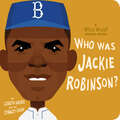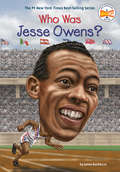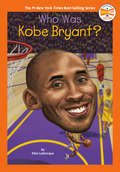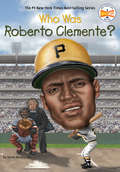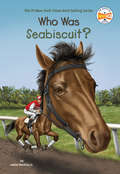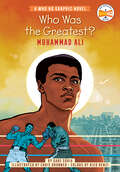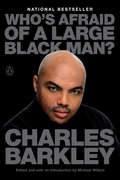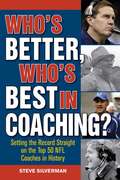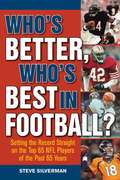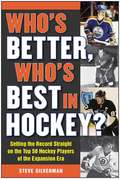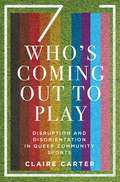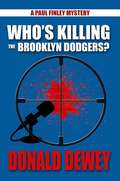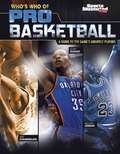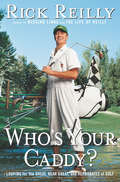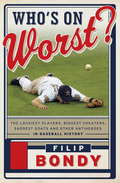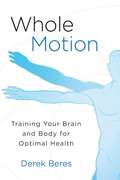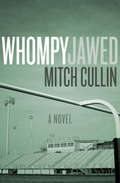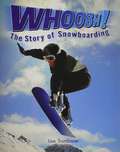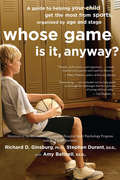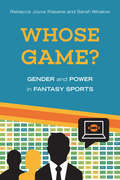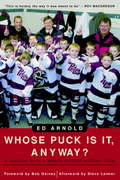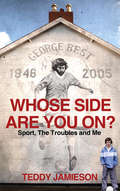- Table View
- List View
Who Was Jackie Robinson?: A Who Was? Board Book (Who Was? Board Books)
by Who HQ Lisbeth KaiserThe latest addition to the Who HQ program: board book biographies of relevant and important figures, created specifically for the preschool audience!The #1 New York Times Bestselling Who Was? series expands into the board book space, bringing age-appropriate biographies of influential figures to readers ages 2-4. The chronology and themes of Jackie Robinson's meaningful life are presented in a masterfully succinct text, with just a few sentences per page. The fresh, stylized illustrations are sure to captivate young readers and adults alike. With a read-aloud biographical summary in the back, this age-appropriate introduction honors and shares the life and work of one of the most influential professional baseball players of our time.WHO WAS? BOARD BOOKS bring inspiring biographies to the youngest readers in an accessible and memorable way.
Who Was Jesse Owens? (Who was?)
by James Buckley Gregory CopelandAt the 1936 Berlin Summer Olympics, track and field star Jesse Owens ran himself straight into international glory by winning four gold medals. But the life of Jesse Owens is much more than a sports story. Born in rural Alabama under the oppressive Jim Crow laws, Owens's family suffered many hardships. As a boy he worked several jobs like delivering groceries and working in a shoe repair shop to make ends meet. But Owens defied the odds to become a sensational student athlete, eventually running track for Ohio State. He was chosen to compete in the Summer Olympics in Nazi Germany where Adolf Hitler was promoting the idea of "Aryan superiority." Owens's winning streak at the games humiliated Hitler and crushed the myth of racial supremacy once and for all.
Who Was Jim Thorpe? (Who Was?)
by James Buckley Who HQLearn about the incredible legacy of the first Native American athlete and Olympian to earn a gold medal for the United States in this exciting addition to the #1 New York Times Best-Selling series.While most athletes excel in just one sport, Jim Thorpe was different. Born in Oklahoma in 1887, he played both professional football and baseball, and ran track and field. Jim was not only a sports icon but also a trailblazer. Raised as part of the Sac and Fox tribal nation, he was the first Native American person to win an Olympic gold medal for the United States. And although his personal life was not always as successful as his career, Jim remains one of the greatest athletes in American history.
Who Was Kobe Bryant? (Who HQ NOW)
by Ellen Labrecque Who HQTold in a new Who HQ NOW format for trending topics, this Who Was? biography details NBA superstar Kobe Bryant's legendary career and the impact of his legacy on the sports world and beyond.Kobe Bryant was just an eighteen-year-old high-school basketball player when he decided to enter the National Basketball Association's draft. Though he was the thirteenth overall pick by the Charlotte Hornets, he would never play a single game for them. Instead, Kobe was traded to the Los Angeles Lakers, where he would spend his entire twenty-season career, winning five championships and numerous awards. Author Ellen Labreque takes readers through each exciting moment, from his iconic dunks to his 81-point game--all the milestones that span Kobe Bryant's legendary career and legacy.
Who Was Roberto Clemente? (Who was?)
by Nancy Harrison James Buckley Ted HammondGrowing up the youngest of seven children in Puerto Rico, Roberto Clemente had a talent for baseball. His incredible skill soon got him drafted into the big leagues where he spent 18 seasons playing right field for the Pittsburgh Pirates. Who Was Roberto Clemente? tells the story of this remarkable athlete: a twelve-time All-Star, World Series MVP, and the first Latin American inducted into the Baseball Hall of Fame.
Who Was Seabiscuit? (Who was?)
by James Buckley Gregory CopelandIn the middle of the worst depression in U.S. history, one young racehorse lifted a nation's spirits. Seabiscuit was born in 1933 on a farm in Kentucky. Though bred for racing, he was weak and undersized. He slept too long and ate too much. Against the odds, he began to win local races. He was given a new coach who trained him to race in larger circuits. Soon enough, this scrappy horse began beating the best racehorses in the country. He became a media darling and won national competitions. In 1938 he was voted U.S. Horse of the Year. Seabiscuit's undying spirit and come-from-behind story made him a celebrity and hero for millions.
Who Was the Greatest?: A Who HQ Graphic Novel (Who HQ Graphic Novels)
by Gabe Soria Who HQ"The Who HQ Graphic Novels series does an excellent job of quickly engaging readers by capturing the drama and immediacy of pivotal historic events." — Booklist Discover the story behind Muhammad Ali and the boxing match that captivated the world, the Thrilla In Manila, in this powerful graphic novel -- written by Murder Ballads' Gabe Soria and illustrated by award-winning artists Chris Brunner and Rico Renzi.Presenting Who HQ Graphic Novels: an exciting new addition to the #1 New York Times Best-Selling Who Was? series!Explore the journey Muhmmad Ali took to win his final match against fellow heavyweight boxing champion Joe Frazier, known as the Thrilla in Manila. A story of athleticism, heart, and determination, this graphic novel invites readers to immerse themselves into the explosive power of the boxing champion and civil rights activist-- brought to life by gripping narrative and vivid full-color illustrations that jump off the page.
Who's Afraid of a Large Black Man?: Speaking My Mind On Race, Celebrity, Sports And American Life
by Charles Barkley Michael WilbonIn this controversial national bestseller, Charles Barkley takes on themajor issue of our time in a series of charged, in-your-face conversations with some of America's most prominent figures-featuring new commentary about New Orleans and the aftermath of Hurricane Katrina.
Who's Better Who's Best in Coaching?: Setting the Record Straight on the Top 50 NFL Coaches in History
by Steve SilvermanRanking the best coaches in NFL history is no easy task. How do we decide which coach had a bigger on-field impact? Or the best tactical skills, both defensively and offensively? Not to mention measuring the strength of what a coach does behind the scenes, how he motivates his players, or how he keeps them from cracking under the pressure. Is the "Hoodie” the greatest coach ever, or just lucky to have Tom Brady? What about Bill Parcells, Vince Lombardi, and John Madden? Where do they rank? Such are the questions that pro football writer Steve Silverman addresses in Who’s Better, Who’s Best in Coaching?. As statistician Elliott Kalb did with baseball, basketball, and golf, and Silverman himself did with football players in Who’s Better, Who’s Best in Coaching?, Silverman takes the next logical step in this new book. Taking the analytical methods he developed over his years as a senior editor at Pro Football Weekly, he applies them to an evaluation of coaches going back to the earliest days of the NFL. The result is a fascinating ranking of the best of the sideline, from legendary old-timers like Vince Lombardi to present-day blue-collar coaches like Tom Coughlin. Throughout, Silverman discusses the many considerations that must be made when comparing modern coaches with coaches of past eras, or when comparing abrasive and domineering coaches with the more relaxed and Zen-like coaches. Including biographical essays on those top fifty coaches and detailed statistics for their career records in both the playoffs and regular season, Who’s Better, Who’s Best in Coaching? is a must-have for anyone who considers football more than just a game and who is fascinated by how it’s coached.
Who's Better, Who's Best in Football?: Setting the Record Straight on the Top 65 NFL Players of the Past 65 Years
by Steve SilvermanWho are the best quarterbacks in NFL history? How about running backs? Wide receivers? How can we objectively rate the performance of individual defensive players? And how can we make reasonable judgments about players at different positions and from different eras? Who is the greatest football player of all time? Jerry Rice? Lawrence Taylor? Jim Brown? Such are the questions pondered by pro football writer Steve Silverman late at night (and during the day). As statistician Elliott Kalb did with baseball, basketball, and golf, Silverman now takes the next step with Who's Better, Who's Best in Football?. Taking the analytical methods he developed over his years as a senior editor at Pro Football Weekly, he applies them to an evaluation of players going back to the earliest days of the NFL. The result is a fascinating ranking of the best of the gridiron, from legendary old-timers like Sammy Baugh to present-day superstars like Peyton Manning. Throughout, Silverman discusses the many considerations that must be made when comparing modern players with players of past eras and players at different positions. Including biographical essays on those top 75 players and detailed statistics for their playing careers, Who's Better, Who's Best in Football? is a must have for anyone who considers football to be more than just a game.
Who's Better, Who's Best in Hockey?: Setting the Record Straight on the Top 50 Hockey Players of the Expansion Era
by Steve SilvermanWho are the best centers in NHL history? How about wingers? How can we objectively rate the performances of individual defensive players? And how can we make reasonable judgments about players at different positions? Who is the greatest hockey player of the Expansion Era? Bobby Orr? Wayne Gretzky? Gordie Howe? Such are the questions debated by hockey columnist Steve Silverman in Who’s Better, Who’s Best in Hockey? In this book, Silverman includes analytics to help evaluate NHL players who have dominated over the last fifty years. The result is a fascinating ranking of the best on the ice, including legendary players like Gordie Howe as well as present-day superstars like Sidney Crosby. Throughout, Silverman discusses the many considerations that must be made when comparing modern players with players of past decades and players at different positions. Including biographical essays on those top fifty players and vital statistics for their playing careers, Who’s Better, Who’s Best in Hockey? is a must-have for anyone who considers hockey to be more than just a sport.
Who's Coming Out to Play: Disruption and Disorientation in Queer Community Sports
by Claire CarterQueer community sports leagues, by their sheer numbers, are changing the energy and space of school gyms and community recreational spaces. Some leagues are well-established – having been in existence for over twenty-five years – whereas others are relatively new, but their collective presence tells stories about the shifting dynamics of queer communities in Canada.Who's Coming Out to Play considers the potential of queer community sports to disrupt notions of the embodiment of gender and community, while maintaining an awareness of numerous factors that limit this potential. Exploring queer teams and leagues of varying sizes and from various locations, this book focuses on leagues that have previously identified as women's or lesbian and are now becoming trans and genderqueer inclusive. Queer community leagues are based in a commitment to community building, prioritizing fun, socializing, and inclusivity over competing or winning. As a result of these commitments, these spaces and the people who come to play in them reflect new ways of being in and with bodies, different ways of embodying gender, and new or different forms of engagement – notably distinct "rules of play" – within sporting arenas.Who's Coming Out to Play paints a vivid picture of the lived experiences of queer bodies in queer sporting spaces, exploring both the possibilities and the continued problems they face.
Who's Killing the Brooklyn Dodgers? (Paul Finley Mysteries)
by Donald DeweyAn old-timer visits New York City for a team reunion, but someone takes him out at the ballgame in this sharp-witted PI mystery. Widowed ex-cop and PI Paul Finley still sticks close to his father-in-law—a bond rooted more in shared grief than shared affection—and one of Joe&’s biggest passions is the annual Brooklyn Dodgers Banquet, where he gets to hang out with the aging heroes of Ebbets Field. But this year, a onetime scrub for the Dodgers is shot to death in the Citi Field press box. Soon afterward, a couple of similar shootings, of a restaurant cook on a subway platform and an accountant on the West Side Highway, suggest more than just isolated incidents of big city violence. Drawn into the case by family promises, Finley seeks a pattern to the shootings—even as they increasingly endanger him and those closest to him—in this fast-moving fourth novel in the compelling contemporary mystery series.
Who's Who of Pro Basketball: A Guide to the Games Greatest Players (Who's Who of Pro Sports)
by Tyler OmothIntroduces readers to the most dynamic pro basketball stars of today and yesterday, including notable statistics and records.
Who's Your Caddy? Looping for the Great, Near Great, and Reprobates of Golf: Looping for the Great, Near Great, and Reprobates of Golf
by Rick ReillyFor "caddy" read confessor, punch-bag, psychotherapist, life-coach, general dogsbody, friend. It's all in a day's work for the men who carry the bag. And if you want to get behind the Pringle sweaters and PR there's no better place to be. Who knows a golfer best? Who's with them every minute of every round, hears their every word, witnesses their despair and triumph? Who knows if, when and how they cheat? The caddy, of course. So when, Rick Reilly, America's most celebrated sportswriter decided he wanted to write a book about golf he put down his pen, picked up the phone, and hired himself out to the great, near great and the reprobates of golf. The results were amazing - John Daly, Tom Lehman, Donald Trump, Deepak Chopra, a blind player, David Duval, a couple of high- rolling hustlers in Vegas and even Jack Nicklaus himself, put their doubts behind them and hand over the bag. In the resulting account Reilly chronicles his experiences in the same inimitable style that makes his back-page column for Sports Illustrated a must-read for more than twenty million people every week. Combining a wicked wit with an expert's eye Who 's Your Caddy? gives us an insight into what makes the game of golf so great. So if you can't get to the course, your short game is in tatters and Big Bertha can no longer deliver on her promises, give yourself a break and sit down and read what it's like for the rest of the world's population of golfers. In Who's Your Caddy? you'll find out - you're not alone. .
Who's on Worst?
by Filip BondyA hilarious celebration of the worst in baseball history: The boneheads, cheats, jerks and losers who make the grand old game so fun Libraries and Internet sites are filled to groaning with debates about who the best ballplayers of all time were--but how many times can you argue about Mantle vs. Mays? Since baseball is a game of failure, it's much more fun to dive into the fray and explore baseball's worst: who was the lousiest pitcher of all-time? the biggest goat? the most despicable owner? the greatest cheater? Filip Bondy wields formidable research, advanced sabermetrics and his considerable wit to provide this indispensable guide to the less glorious side of our national pastime. Each chapter is filled with rich and colorful stories of the players unfortunate enough to be chosen in each category and is followed by a handy top-ten list, such as Most Overpaid Yankees. From a delightful survey of batters who fell below the dreaded "Mendoza Line" to a rundown of managers who had long careers distinguished by relentless losing to a roster of players who took steroids but still stunk, Who's on Worst? is a thoroughly entertaining portrait of the personalities who deserve their place in baseball history as much as the immortals.
Whole Motion: Training Your Brain and Body for Optimal Health
by Derek BeresModern fitness is not just about how we move our bodies; it’s about how we move our brains as well. Whole Motion offers a complete picture of how to strengthen your resolve, gain laser-sharp focus, boost your ability to remember, calm your anxiety levels, master your emotional responses, and embody your body like never before. Author Derek Beres uncovers the latest research in how the brain is affected by a number of different exercise formats. The book offers sample workouts designed to give your brain the greatest stimulation and regeneration possible.Whole Motion is divided into two main sections. In the Movement section, Beres looks at the movement science and neuroscience behind Feldenkrais, strength training, HIIT, yoga, and meditation. He reveals the latest research behind each movement discipline and incorporates anecdotal examples from clients and students. He also includes information on when and why to perform each exercise.In the Mind section, Beres investigates the other side of fitness: nutrition, regeneration, flow, and disruption, as well as how to choose music for optimal workouts and the neurological cost of distraction. This section is the lifestyle component, focusing on how to create the best environment to achieve a sense of completeness in brain and body.
Whole-Body Cryostimulation: Clinical Applications
by Paolo CapodaglioThis book entails chapters ranging from cell to clinical studies exploring the state-of-the-art of the molecular and clinical effects of Whole-Body Cryostimulation (WBC). Based on consolidated evidence, WBC is nowadays widely used in elité athletes for recovery from muscle fatigue or injury but, despite growing scientific support, it remains a niche topic in the field of Rehabilitation. At present, WBC is used mostly in eastern Europe as add-on treatment for rheumatological conditions, but recent literature suggests that its positive effects can have a clinically significant impact on a wider range of conditions. The novelty of the book consists of documenting the clinical and functional effects of WBC in a range of conditions including post/long-Covid symptoms, fibromyalgia, rheumatologic, metabolic, psychiatric, sleep and respiratory disorders, multiple sclerosis, Parkinson disease, spasticity.It addresses clinicians, researchers and postgraduate students, trying to provideevidence-based support for the use of WBC in pain and fatigue reduction, and improvement in functioning, mood, quality of sleep in various clinical conditions. The recently unveiled metabolic effects of the chronic exposure to cryogenic temperatures represent cutting-edge research in the field of obesity and diabetes management. The book describes the work-in-progress of an international panel of experts and provides the latest indications for a safe use of WBC in the clinical setting in different medical conditions. It is about time to pinpoint to the clinical audience the current achievements on this topic together with the limitations of the existing studies, the lack of standard protocols with regard to individual “doses” of cryogenic exposure in specific health conditions and the safety concerns in order to foster research on the application of clinically useful and safe WBC protocols as add-on treatments able to boost rehabilitation programs.
Whole-Body Electromyostimulation: Effects, Limitations, Perspectives of an Innovative Training Method (essentials)
by Michael Fröhlich Wolfgang Kemmler Christoph EiflerThis essential is intended as a compact reference for issues and aspects related to the innovative training technology of whole-body electromyostimulation (WB-EMS). In addition to background and information on WB-EMS application, in which the authors pay particular attention to safe and effective use, there is a current overview of research results summarizing the effects of WB-EMS on various target outcomes. Finally, a characterization of the market situation, current trends and a forecast of developments in the field of WB-EMS is presented.
Whompyjawed: A Novel
by Mitch CullinWhompyjawed: 1. Askew, out of place 2. Off-center or crooked 3. (informal) a person of eccentric or questionable character; odd. Football is Willy Keeler's ticket out of West Texas, but only if he can keep the explosive combination of his intellect and hormones from destroying his high-school career. Not an easy task as he also contends with the endless demands of his girlfriend, mother, coach, and college recruiters. When a startling sexual encounter with a classmate and a consuming infatuation with one of his mother's friends threaten to shatter his fragile balance, Willy discovers that simply figuring out who he is may be the greatest challenge of all. Reminiscent of The Catcher in the Rye and The Last Picture Show, Mitch Cullin's Whompyjawed is an unforgettable coming-of-age story, told with unparalleled humor and compassion.
Whoosh: The Story of Snowboarding (Into Reading, Level N #72)
by Lisa TrumbauerNIMAC-sourced textbook <p><p> Does sliding downhill on the snow at high speed sound like fun to you? If so, you’d like snowboarding!
Whose Game Is It, Anyway?: A Guide to Helping Your Child Get the Most from Sports, Organized by Age and Stage
by Amy Baltzell Richard D. Ginsburg Stephen DurantIn an era when parents and kids are overwhelmed by a sports-crazed, win-at-all-costs culture, here is a comprehensive guide that helps parents ensure a positive sports experience for their children. In Whose Game Is It, Anyway? two of the country’s leading youth sports psychologists team up with a former Olympic athlete and expert on performance enhancement to share what they have gleaned in more than forty years of combined experience.The result is a book unique in its message, format, and scope.Through moving case studies and thoughtful analyses, Ginsburg, Durant, and Baltzell advocate a preventive approach through a simple three-step program: know yourself, know your child, know the environment.They look at children in age groups, identifying the physical, psychological, and emotional issues unique to each group and clarifying what parents can expect from and desire for their kids at every stage.They also explore myriad relevant topics, including parental pressure, losing teams, steroid use, the overscheduled child, and much more.Illuminating, impassioned, and inspiring, Whose Game Is It, Anyway?is required reading for anyone raising—or educating—a child who participates in sports.
Whose Game?: Gender and Power in Fantasy Sports (Sporting #32)
by Rebecca Joyce Kissane Sarah WinslowFantasy sports have the opportunity to provide a sporting community in which gendered physical presence plays no role—a space where men and women can compete and interact on a level playing field. Whose Game? shows, however, that while many turn to this space to socialize with friends or participate in a uniquely active and competitive fandom, men who play also depend on fantasy sports to perform a boyhood vision of masculinity otherwise inaccessible to them. Authors Rebecca Kissane and Sarah Winslow draw on a rich array of survey, interview, and observational data to examine how gender, race, and class frame the experiences of everyday fantasy sports players. This pioneering book examines gendered structures and processes, such as jock statsculinity—a nerdish form of masculine one-upmanship—and how women are often rendered as outsiders. Ultimately, Whose Game? demonstrates that fantasy sports are more than just an inconsequential leisure activity. This online world bleeds into participants’ social lives in gendered ways—forging and strengthening relationships but also taking participants’ time and attention to generate negative emotions, stress, discord, and unproductivity.
Whose Puck Is It, Anyway?
by Ed ArnoldEvery winter, in hockey arenas across North America, as soon as the kids step onto the ice, the abuse begins. Coaches yell at the players, parents yell at the coaches, and everyone yells at the referees. After nearly a decade of coaching youngsters, Ed Arnold decided he wanted kids to learn the fundamentals of hockey but he also wanted them to have fun. He got support in this enterprise from two former NHL players, goalie Greg Millen and forward Steve Larmer. Concerned that the children's game was being taken far too seriously by both parents and coaches, they also believed that the kids were losing the opportunity to reinvent the game for themselves.So it came about that in the winter of 2000, when the parents of the would-be Minor Novice Peterborough Petes showed up with their kids for tryouts, they were handed a letter outlining the coaches' new philosophy. There would be no yelling at players, coaches, or referees. Players would play all positions. They would not be forced to follow a "systems" approach to hockey, but would be left to figure out what to do in a given situation for themselves. And all members of the team would be given equal ice time.Not every parent liked it, but the kids sure had a good time. Readers of this inspiring book will have a wonderful time, too, as they follow the adventures of the team. Coach Larmer wears a Stanley Cup ring but he meant exactly what he said when he told a reporter that his year with the kids was the most fun he ever had in hockey.From the Hardcover edition.
Whose Side Are You On?
by Teddy JamiesonFrom the late 1960s, Northern Ireland has been mired in violence. Yet it has had seen more than its fair share of sporting heroes - from footballer George Best, through snooker champion Alex Higgins, to boxer Barry McGuigan. Life was tough for these working-class lads, but they could shine on the football field or find refuge at the town boxing club. For other kids, like the young Teddy Jamieson, a knockabout in the back-lanes was as good as it got, but at least they had their heroes. Watching McGuigan on telly, Teddy could feel proud to be Northern Irish. But sport - like everything else in Northern Ireland - could quickly turn nasty when politics were involved. This extraordinary journey through sport and the Troubles has it all: from Olympic gold-medals to Gaelic football; from death threats to reconciliations. Then there is Teddy's own story, as we learn how the age-old playground question 'Whose side are you on?' doesn't always have an easy answer.
